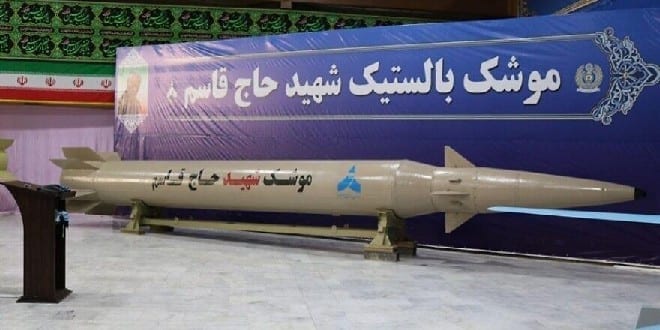The Middle East Media Research Institute posted a video in which reported on an interview with Yemeni Houthi politician Ali Al-Halili, the spokesman of the Future of Justice Party, on Ofogh TV (Iran) on Tuesday. In the interview, Al-Halili said that the UAE’s “obscene” act of normalizing relations with Israel will not be met with silence by the Yemenis.
“Today, the UAE is fighting against us,” Al-Halili said. “We have the right to speak, to do something, or even to fight. This is a legitimate right. It is self-defense…Israel wanted to operate clandestinely in Yemen but it failed. So now it wants to do it publicly.”
“Yemen’s fighters and mujahideen, and among them the leader of the revolution, said a few months ago that we will strike Israel. We have missiles that can strike Israel and we will strike Israel and the Zionists. Today, we also say that the UAE has turned into a second Israel in the region.”
“The Emiratis said today that they have given the island of Socotra to Israel,” Al-Halili said.
This was a reference to a recent visit by a delegation of Israeli and Emirati intelligence personnel to the island in the Arabian Sea for the purpose of establishing planned intelligence bases designed to collect intelligence across the region. The island was part of Yemen but the UAE established a military base on the island in 2016 as part of the Saudi-led intervention in the Yemeni civil war.
He added that the UAE and Israel have united into one entity and are in a war against Yemen. MEMRI noted with interest that during the interview, Al-Halil spoke in fluent Farsi as spoken in Iran rather than in his native Arabic as spoken in Yemen.
Al-Halili claimed that the Houthis are in possession of missiles with a range of 1,500-2,500 kilometers (900-1,500 miles). Yemen is over 2,200 kilometers from Israel however the UAE is just over 1,000 kilometers.
The Houthis are an Islamic political and armed movement that emerged from northern Yemen in the 1990s. In 2014, the Houthis took over the government in Sanaa and have gained control of most of the northern part of Yemen’s territory. The Houthis have launched repeated missile and drone attacks against Saudi cities, widely seen as a proxy war between Saudi Arabia and Iran.
In 2019, the Houthis claimed responsibility for a drone strike that hit the state-owned Saudi Aramco oil processing facilities at Abqaiq. The strike cut Saudi Arabia’s oil production by about half, representing about 5% of global oil production, and caused some destabilization of global financial markets. Saudi Arabian officials said that the drones and cruise missiles used for the attack originated from the north and east and that they were of Iranian manufacture. The United States and Saudi Arabia have stated that Iran was behind the attack while France, Germany, and the United Kingdom jointly stated Iran bears responsibility for it. Iran has denied any involvement.
Last week, the Houthi rebels in Yemen, attacked targets in Riyadh, the Saudi Arabian capital. They used armed drones and the Zulfiqar short-range ballistic missile. It is believed that Iran played a role in the attack.
In fact, Al-Halili’s threat comes at a time when Iran is touting improved missile capabilities. Last week, the Iranian Afkar News posted an article with the headline, “American Soil Is Now Within the Range of Iranian Bombs.”
“By sending a military satellite into space, Iran now has shown that it can target all American territory; the Iranian parliament had previously warned [the U.S.] that an electromagnetic nuclear attack on the United States would likely kill 90 percent of Americans,” the article read. “The same type of ballistic missile technology used to launch the satellite could carry nuclear, chemical or even biological weapons to wipe Israel off the map, hit US bases and allies in the region and US facilities, and target NATO even in the far west of Europe.”
The announcement of the new missile came one day after the United Nations Security Council voted in favor of lifting the arms embargo on Iran.
Also last week, an Iranian Navy’s Qadir-class submarine launched an anti-ship cruise missile in the main stage of a war game, the spokesperson for the drill said.
“This is not about deterrence; it’s about attacking any target that could pose a threat for Iran,” Rear Admiral Hossein Khanzadi said on state television.
The spokesman added that at all submarines of the Iranian Navy are going to be armed with the missile. The Simorgh missile has a range of 1,500 kilometers and a service ceiling of 25,000 feet. The Iranian navy also test-fired a “Ghader” land-to-sea cruise missile.
As part of the Joint Comprehensive Plan of Action (JCPOA), known commonly as the Iran nuclear deal or Iran deal and adopted in 2015, Iran agreed, in theory, to restrict its nuclear program to peaceful purposes for ten years. In conjunction with the JCPOA, Iran also signed United Nations Security Council Resolution 2231 which “calls upon Iran not to undertake any activity related to ballistic missiles designed to be capable of delivering nuclear weapons, including launches using such ballistic missile technology.” Iran has never abided by the guidelines of this resolution.




